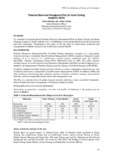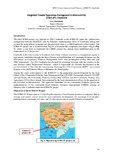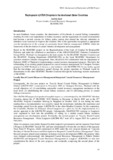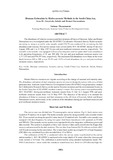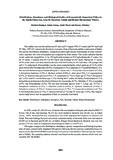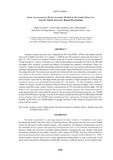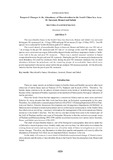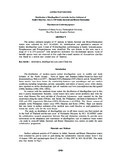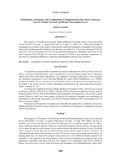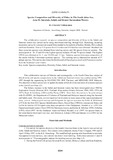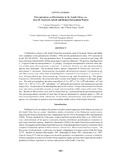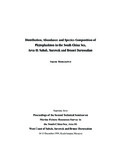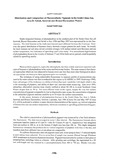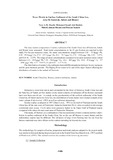01 SEAFDEC/TD Publications: Recent submissions
381-400 / 1030
-
Fisheries Resources Management Plan for Kuala Teriang Langkawi, Kedah
(Training Department, Southeast Asian Fisheries Development Center, 2008) -
Outcomes of the Baseline and Monitoring Socio-economic Surveys
(Training Department, Southeast Asian Fisheries Development Center, 2008) -
Report on the Biological Study (LBCRM-PL/ICRM-PL, Kuala Teriang, Langkawi, Malaysia)
(Training Department, Southeast Asian Fisheries Development Center, 2008) -
Integrated Coastal Resources Management in Sihanoukville (ICRM-SV), Cambodia
(Training Department, Southeast Asian Fisheries Development Center, 2008) -
Integrated Coastal Resources Management in Pathew District (ICRM-PD), Chumphon Province, Thailand
(Training Department, Southeast Asian Fisheries Development Center, 2008) -
Deployment of ICRM Projects in the Southeast Asian Countries
(Training Department, Southeast Asian Fisheries Development Center, 2008) -
Biomass Estimation by Hydro-acoustic Methods in the South China Sea, Area II: Sarawak, Sabah and Brunei Darussalam
(Training Department, Southeast Asian Fisheries Development Center, 1999)The abundance of fisheries resources and their structure off shore of Sarawak, Sabah and Brunei Darussalam were investigated under the SEAFDEC Collaborative Research Survey. Hydro-acoustic surveying by using a scientific ... -
Distribution, Abundance and Biological Studies of Economically Important Fishes in the South China Sea, Area II: Sarawak, Sabah and Brunei Darussalam Waters
(Training Department, Southeast Asian Fisheries Development Center, 1999)The studies were carried out between 9th July and 3rd August 1996 (3rd cruise) and 30th April and 30th May, 1997 (4th cruise) in the Exclusive Economic Zone of Sarawak and the western part of Sabah. The species distribution, ... -
Stock Assessment by Hydro-acoustic Method in the South China Sea Area II: Sabah, Sarawak, Brunei Darussalam
(Training Department, Southeast Asian Fisheries Development Center, 1999)Acoustic resource surveys were conducted by M/V SEAFDEC off Sarawak, Brunei and the east coast of Sabah from July 10 to August 2, 1996 for pre-NE monsoon season and from May 1 to May 24, 1997 for post-NE monsoon season, ... -
Temporal Changes in the Abundance of Macrobenthos in the South China Sea, Area II: Sarawak, Brunei and Sabah
(Training Department, Southeast Asian Fisheries Development Center, 1999)The macrobenthic fauna in the South China Sea (Sarawak, Brunei and Sabah) was surveyed during pre NE monsoon (4 Jul.- 8 Aug. 1996) and post NE monsoon (25 Apr.-31 May 1997). Over 90 species were collected by Smith-McIntyre ... -
Distribution of Dinoflagellate Cysts in the Surface Sediment of South China Sea: Area 2. Off Sabah, Sarawak and Brunei Darussalam
(Training Department, Southeast Asian Fisheries Development Center, 1999)The surface sediment samples of 47 stations in Sabah, Sarawak and Brunei Darussalam waters were collected by M.V. SEAFDEC for identification and quantitative analysis of benthic dinoflagellate cysts. A total of 18 ... -
Distribution, Abundance and Composition of Zooplankton in the South China Sea, Area II: Sabah, Sarawak and Brunei Darussalam Waters
(Training Department, Southeast Asian Fisheries Development Center, 1999)The samples of 79 stations in Sarawak, Sabah and Brunei Darusalam waters were collected by M.V. SEAFDEC on 4 July - 9 August 1996 and on 25 April - 31 May 1997. Thirty-eight groups of zooplankton were found in this study. ... -
Kind, Abundance and Distribution of the Fish Larvae in the South China Sea, Area II: Sarawak, Sabah and Brunei Darussalam
(Training Department, Southeast Asian Fisheries Development Center, 1999)Fish larvae samples were obtained from 79 stations in South China Sea of the Sarawak , Brunei and Sabah during the pre northeast monsoon season (August - September 1996) and the post northeast monsoon (April - May 1997). ... -
Species Composition and Diversity of Fishes in the South China Sea, Area II: Sarawak, Sabah and Brunei Darussalam Waters
(Training Department, Southeast Asian Fisheries Development Center, 1999)The collaborative research on species composition and diversity of fishes in the Sabah and Sarawak waters was carried out by using otter-board trawling, through K.K. Manchong, including taxonomic survey for commercial ... -
Microplankton on Distribution in the South China Sea, Area II: Sarawak, Sabah and Brunei Darussalam Waters
(Training Department, Southeast Asian Fisheries Development Center, 1999)Collaborative cruises in the South China Sea around the coast of Sarawak, Brunei and Sabah were conducted in the premonsoon (October, 1996) and the postmonsoon (June, 1997) periods on board MV SEAFDEC. The microplankton ... -
Distribution, Abundance and Species Composition of Phytoplankton in the South China Sea, Area II: Sabah, Sarawak and Brunei Darussalam
(Training Department, Southeast Asian Fisheries Development Center, 1999)Four hundred and four samples of phytoplankton were collected from 79 stations in Sabah, Sarawak and Brunei Darussalam waters, during 2 cruises of M.V. SEAFDEC, 10 July - 2 August 1996 and 1 – 24 May 1997. The Samples were ... -
Primary Production Determination in the South China Sea, Area II: Sabah, Sarawak and Brunei Darussalam Waters
(Training Department, Southeast Asian Fisheries Development Center, 1999)Primary production in the South China Sea, off Sabah, Sarawak and Brunei Darussalam was determined from in situ fluorescence, light intensity and the uptake of radioactive carbon incubation on the MV.SEAFDEC cruise in ... -
Distribution and Composition of Photosynthetic Pigments in the South China Sea, Area II: Sabah, Sarawak and Brunei Darussalam Waters
(Training Department, Southeast Asian Fisheries Development Center, 1999)Depth integrated biomass of phytoplankton in the southern part of the South China Sea off Sarawak, Brunei Darussalam and Sabah in July 1996 and May 1997 was represented by in situ fluorescence. The total biomass in the ... -
Trace Metals in Surface Sediment of the South China Sea, Area II: Sarawak, Sabah and Brunei
(Training Department, Southeast Asian Fisheries Development Center, 1999)The trace metals composition of surface sediment of the South China Sea off Sarawak, Sabah and Brunei were measured. Total metal concentrations in the 63 ?m fraction are reported in this study. For the pre-monsoon cruise, ... -
Trace Metal Concentrations and Distributions in Sea Water of the South China Sea, Area II: Sabah, Sarawak and Brunei Darussalam
(Training Department, Southeast Asian Fisheries Development Center, 1999)Water samples off Sabah, Sarawak and Brunei Darussalam were collected during July–August 1996 and May 1997 and analyzed for dissolved and particulate cadmium, copper, iron, lead and nickel. Dissolved metals were coprecipitated ...

